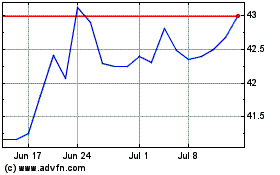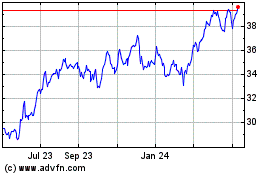Texas Showdown Flares Up Over Natural-Gas Waste
July 17 2019 - 7:29AM
Dow Jones News
By Rebecca Elliott
A pipeline company is challenging Texas' practice of allowing
drillers to set unwanted natural gas on fire, in a case that could
test state limits for how much of the fuel can legally go to
waste.
As shale companies turned America into the world's top oil
producer, they unlocked massive quantities of natural gas as a
byproduct and Texas has allowed them to freely burn off vast
volumes as area pipelines fill up. The process is known as
flaring.
Now, shale producer Exco Resources Inc. is seeking to flare
nearly all of the gas produced by a group of South Texas wells,
even though its operations are already connected to a network of
pipelines. Williams Cos., the operator of the pipelines, is
challenging the request, in what is believed to be the first such
dispute on record.
Williams attorney John Hays Jr. told commissioners in a hearing
last month that granting Exco's request would open the door to
wasting gas any time doing so is more profitable than transporting
it.
The Texas Railroad Commission has received more than 27,000
requests for flaring permits in the past seven years and has not
denied any of them, records show.
"It just doesn't feel right, quite frankly, to have a standard
that says, any time there's an application, you get an exception,"
Mr. Hays said. "Then why have the statute in the first place?"
Exco has said that rejecting the company's permit application
could force a shutdown of the wells. Attorney David Nelson argued
at the hearing that doing so potentially would reduce long-term oil
production. The company recently emerged from bankruptcy. It
declined to provide additional comment.
The case underscores the tensions surfacing in Texas as the
state grapples with booming oil production and its side effects. It
also exposes a growing rift between frackers and pipeline companies
as the natural-gas glut is set to worsen.
Natural-gas pipeline construction in Texas, home to America's
hottest oil field, the Permian Basin, has lagged far behind
production growth, in part because producers have been reluctant to
commit to long-term contracts. The state's gas output is expected
to increase about 30% over the next five years, according to
consulting firm RBN Energy.
In the region's two largest oil basins, the Permian Basin and
Eagle Ford, operators flared or vented -- where gas is released
without being burned -- into the atmosphere an average of about 740
million cubic feet of gas a day during the first quarter, according
to public data compiled by energy analytics firm Rystad Energy.
That gas would be worth about $1.8 million a day at current prices
and produced greenhouse gas emissions equivalent to that of nearly
five million cars driving for a day, according to estimates from
the World Bank and the Environmental Protection Agency.
Case examiners for the Railroad Commission recommended that
Exco's permit be approved, but the agency's elected commissioners
delayed their vote last month. They are expected to revisit the
matter as soon as August.
Railroad Commission Chairman Wayne Christian declined to
comment. Williams Cos. declined to provide additional comment
pending the Railroad Commission's ruling.
Regulators' decision will have consequences, regardless of which
way it goes. Restricting flaring could cause drillers to curtail
oil production and give pipeline companies additional leverage to
secure contracts and build new infrastructure. Granting flaring
permits in cases such as Exco's could make pipeline companies less
willing to risk building new conduits.
"If they're not willing to limit flaring in this case, then
there's really no regulatory limit on flaring in Texas," said Gary
Kruse, research director for analytics firm LawIQ.
Exco and Williams are fighting over how much the producer should
pay to access the pipeline network.
If the price is too high, Exco says, then it is cheaper to flare
gas than pay for transportation. Although the case involves wells
in South Texas, the conditions mirror those for many operators in
the Permian Basin, the center of Texas' boom.
"The question is: How much onus or economic burden should be put
on a producer to force them to capture and connect that gas?" said
Robert W. Baird & Co. analyst Ethan Bellamy. "Where is the
tipping point?"
Write to Rebecca Elliott at rebecca.elliott@wsj.com
(END) Dow Jones Newswires
July 17, 2019 07:14 ET (11:14 GMT)
Copyright (c) 2019 Dow Jones & Company, Inc.
Williams Companies (NYSE:WMB)
Historical Stock Chart
From Aug 2024 to Sep 2024

Williams Companies (NYSE:WMB)
Historical Stock Chart
From Sep 2023 to Sep 2024
